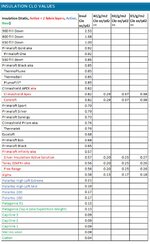JP100
WKR
Hi guys
Over the last couple of years I have tried a Synthetic bag in various conditions and been left a bit disappointed, this season my guide tried one and was of the same view as me(cold).
Yesterday I was trying to do some more research into actual comparisons, which is difficult as everyone 'feels' cold differently but there are more scientific methods to test insulation(you would hope).
I came across this page Outdoor Gear Insulation Ratings Explained – The Adventure Poet
with the below table
According to this chart Climashield and Primaloft One/Gold are both pretty similar, with a slight advantage to Primaloft. But both are near HALF the value of 800 loft down.
That being the case a Climashield or Primaloft bag/jacket would have to be near twice the weight of a down one for the same warmth???
I have a Climashield bag and down bag that are about the same weight, and the down bag is miles ahead for sure, hard to say how much 'warmer' it is, but its alot better.
Using Mountain Equipment as an example they have two bags with more or less the same ratings(minus 18C comfort), and the down bag(Kyros) weighs 1200 grams/43 oz and the Synthetic bag(Aurora v) weighs 2380 grams/84 oz. (Products Comparison List - Mountain Equipment)
So this does appear that synthetics will be twice the weight for the same warmth.
I think this is pretty surprising to me, I have not used synthetic insulation much, and didnt think it was that far behind down.
There is alot of brands out there that make some pretty outrages claims to their bags warmth and I think this is good to keep in mind, I dont trust any sleeping bag rating unless it has an EN 13537 rating.
Does anyone else have any real tests/fact to prove/ dis prove this??
Over the last couple of years I have tried a Synthetic bag in various conditions and been left a bit disappointed, this season my guide tried one and was of the same view as me(cold).
Yesterday I was trying to do some more research into actual comparisons, which is difficult as everyone 'feels' cold differently but there are more scientific methods to test insulation(you would hope).
I came across this page Outdoor Gear Insulation Ratings Explained – The Adventure Poet
with the below table
| Type of Insulation | CLO-value (clo/oz/yd2) |
| 550 fill Down | 0.7 |
| 650 fill Down | 1.0 |
| 800+ fill Down | 1.68 |
| Climashield APEX | 0.82 |
| Coreloft by Arctyrex | 140 grams/sq m clo = 4.01, noted to be 5% less than Primaloft One |
| Down-Tek (Water resistant Down) | Similar to Down |
| DriDown: 600-fill down by Sierra Designs | Similar to Down |
| Exceloft by Mont-bell | 0.68 |
| Marmot Thermal R Eco | 0.8 |
| Polarguard by Invista | 0.488 |
| Primaloft Eco | Dry: 0.68(0.020 clo/g/m2) Wet: 0.60 (0.017 clo/g/m2) |
| Primaloft Eco Footwear | Dry: 0.250 m2 C/W/IN (0.100 m2 C/W/CM) Wet: 0.115 m2 C/W/IN (0.046 m2 C/W/CM) |
| Primaloft Infinity | Dry: 0.57 (0.017 clo/g/m2) Wet: 0.47 (0.014 clo/g/m2) |
| Primaloft One | Dry: 0.92 (0.027 clo/g/m2) Wet: 0.90 (0.026 clo/g/m2) |
| Primaloft Sport | Dry: 0.79 (0.023 clo/g/m2) Wet: 0.72 (0.021 clo/g/m2) |
| Primaloft Synergy | Dry: 0.73 (0.022 clo/g/m2) Wet: 0.61 (0.018 clo/g/m2) |
| Primaloft Black | 0.65 |
| Primaloft Silver | 0.79 |
| Primaloft Gold | 0.92 |
| Thermolite | Dry: 2.9 CLO/cm Wet:1.55 CLO/cm |
| Thinsulate type C, CS and CDS 100 | 0.419 |
| Thinsulate type C, CS and CDS 150 | 0.413 |
| Thinsulate type C, CS and CDS 200 | 0.403 |
| Thinsulate type C, CS and CDS 40 | 0.538 |
| Thinsulate type C, CS and CDS 70 | 0.455 |
According to this chart Climashield and Primaloft One/Gold are both pretty similar, with a slight advantage to Primaloft. But both are near HALF the value of 800 loft down.
That being the case a Climashield or Primaloft bag/jacket would have to be near twice the weight of a down one for the same warmth???
I have a Climashield bag and down bag that are about the same weight, and the down bag is miles ahead for sure, hard to say how much 'warmer' it is, but its alot better.
Using Mountain Equipment as an example they have two bags with more or less the same ratings(minus 18C comfort), and the down bag(Kyros) weighs 1200 grams/43 oz and the Synthetic bag(Aurora v) weighs 2380 grams/84 oz. (Products Comparison List - Mountain Equipment)
So this does appear that synthetics will be twice the weight for the same warmth.
I think this is pretty surprising to me, I have not used synthetic insulation much, and didnt think it was that far behind down.
There is alot of brands out there that make some pretty outrages claims to their bags warmth and I think this is good to keep in mind, I dont trust any sleeping bag rating unless it has an EN 13537 rating.
Does anyone else have any real tests/fact to prove/ dis prove this??

